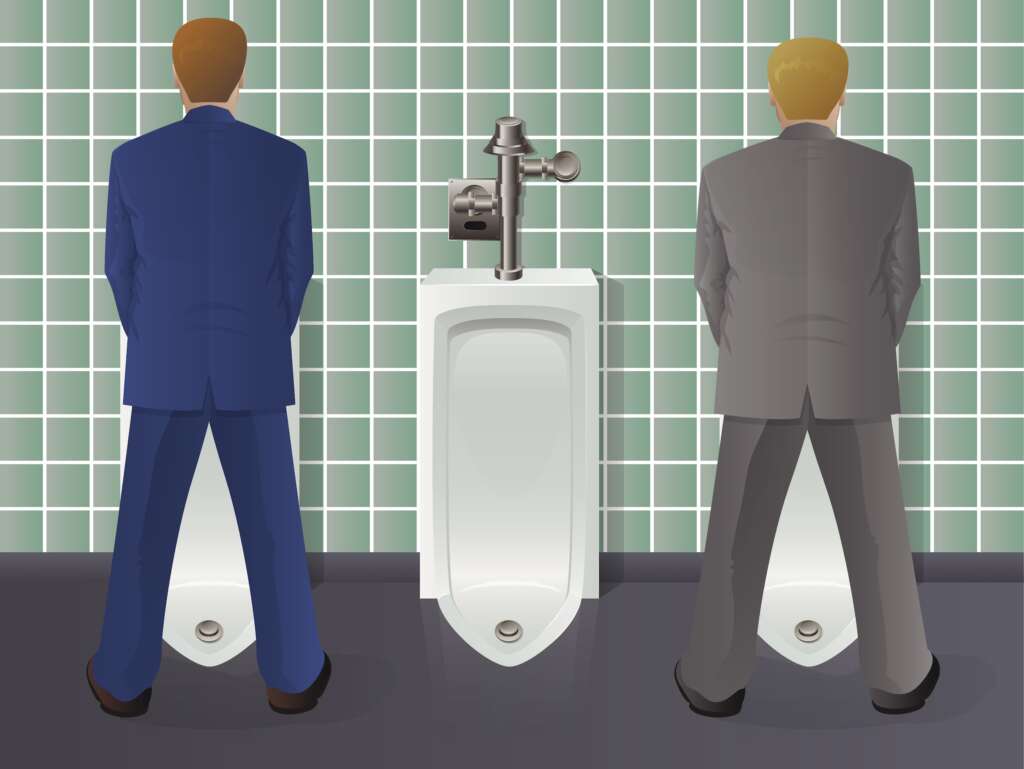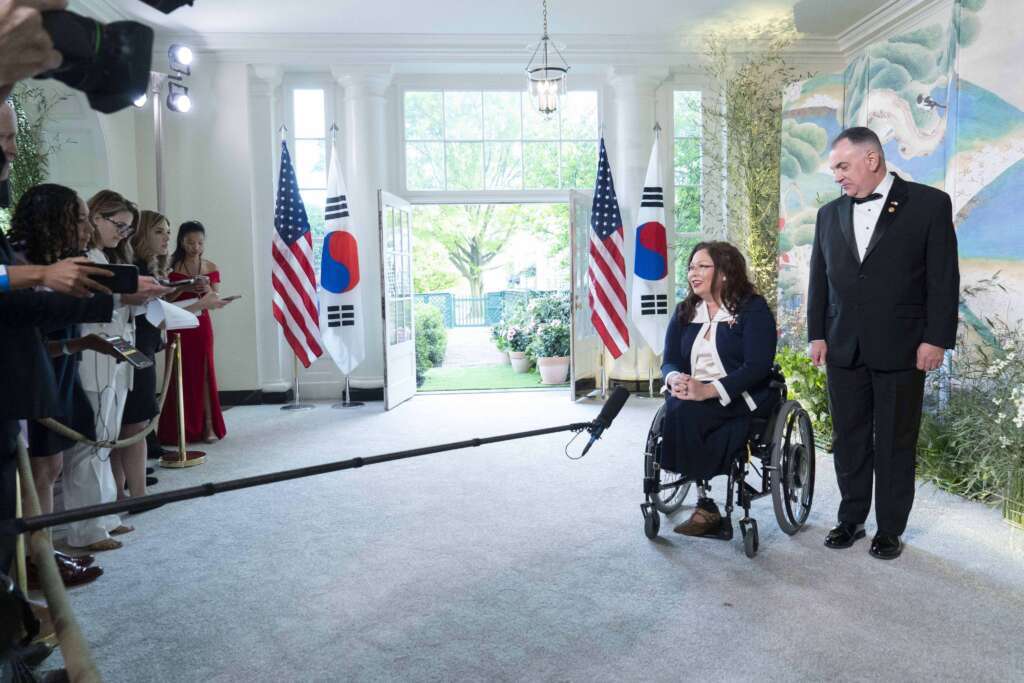I remember the first time I saw a truly handicapped person working in public. He was a young man with Downs Syndrome who worked at the local WalMart store as a greeter. People would come in and he would wave at them and smile. Don’t bother asking him where the loungerie department was or whether there was still a sale on studded snow tires. He would not be able to process sophisticated questions or anything other than very basic communication. But he would smile and wave and other customers enjoyed seeing him as much as I did. I had heard bad things about Walmart moving into an area and driving the local “Mom and Pop” stores and pharmacies out of business. But this opportunity provided by Walmart gave this young man something to look forward to, and he clearly enjoyed his job greeting folks. He had a blue vest with his first name in big letters on the name tag. He felt like he truly belonged to something bigger than himself. People were approaching him to talk to him instead of pretending not to see him. After a year or two, the greeter was replaced by a very senior man (i.e. older than I) in a wheel chair. Another kudo for Walmart. People of various abilities enjoying the dignity of work. You don’t have to be German to appreciate that! Your just have to be woke! When Deena and I got married, she took me to a restaurant in a Texas city where everyone who worked there was a special needs student. It was a wonderful, rewarding experience for both students and patrons.
Not everyone is born with a physical or intellectual challenge like the young man with Downs. The older man in the wheel chair had just outlived his body. People half his age in outstanding health can get hit by a drunk driver, or suffer a stroke following a broken leg. What of their careers? What of Tammy Duckworth who at the age of 36 had both of her legs blown off (one at the hip, the other at the knee) by a rocket-propelled grenade over Iraq?
Those of you who have followed my blog over the years or who know me personally know that I often—and stubbornly—take up lost causes. As a child, I would try to save baby birds that fell out of the nest or talk my parents into letting me adopt an orphaned fawn, or at least a few stray kittens as a consolation prize. I try to be a caring person as an adult, though because I am an imperfect being, I sometimes fail. As an adult, my career in the military led me to opportunities to care for the sick and wounded and from there, I taught and hopefully inspired others to care likewise while assigned to the USAF Nursing Services School. Now, when many in our country don’t give a whit about the “least of these” Americans or people in the world, I still, stubbornly try. I guess I’m just throwing starfish into the sea, but then again, life is a matter of scale.
One of the frustrations I encounter is the tendency of some political commentators to reduce a complex issue into a single sentence (or less.) “Taxes are bad.” “Guns are good.” Another frustration is resort to ad hominem attacks, such as referring to the U.S. West Coast as “The land of fruit and nuts” as many radio talk show hosts were and still are want to do. A pejorative remark like that attempts to invalidate anything of value that could come out of California, Oregon or Washington. So it is with Diversity, Equity, and Inclusion (DEI.)
I was looking for a term that describes the practice of unfairly blaming the ills in society on a specific group or policy, so I consulted AI. Here’s what Apple AI wrote back:
“Scapegoating refers to the practice of unfairly blaming a person or group for problems or negative outcomes, allowing others to deflect responsibility or attention from the actual causes. In a societal context, it often involves attributing a wide range of societal issues to a single factor, group, or individual, simplifying complex problems into a single narrative. This can exacerbate divisions and lead to further societal conflict.”
SO SCAPEGOATING IT IS

I was a bit surprised that there wasn’t a different term, but the definition seems to fit. So, I’ll use if for the sake of this essay. And for the core of this post, I want to visit the DEI issue, which has definitely fallen out of the nest of late and is about to be roughly and rudely obliterated from American life. Even now, the term is being ruthlessly purged from government servers and from the homepages of corporations that once embraced it and benefited from it. DEI has become a litmus test to see how loyal companies and policymakers are to the Make America Great Again (MAGA) movement in general and to our Leader in particular. On the surface, I cannot understand the evil in believing and supporting terms such as “diversity” or “equity” or “inclusion,” yet alone threatening people who welcome disabled Americans with termination or prosecution. It’s like waking up one morning and being told that cardiopulmonary resuscitation and apple pie are leading to the decline of Western Civilization and will not be performed–or consumed–under any circumstance as the case may be. So, I want to dig a little deeper into the issue to try to move beyond a few lines of a “Truth Social post” written on a fourth grade reading grade-level at three a.m.
HOW WE GOT HERE
The roots of DEI go back sixty years to the Civil Rights Movement which laid the foundation for DEI policies. Key legislation, such as the Civil Rights Act of 1964, prohibited discrimination based on race, color, religion, sex, or national origin. The bill passed the House of Representatives by a 290-130 margin and the Senate 73-27. establishing a legal framework that influenced later DEI initiatives. Predictably, conservatives opposed the legislation for any of a number of reasons including states’ rights and a willingness to let minorities suffer from “benign neglect.” Once President Lyndon Johnson signed the bill into law, it became a standard for the federal courts in America to evaluate everything from hiring practices to reapportionment to red-lining mortgages and probably marriage and interracial adoption policies as well. Around this time in America, a white person could routinely get $125,000 or $250,000 in term life insurance but in some states, a black person could only qualify for $3,500 or so which was the cost to bury someone back then.
Over the years, case law and additional pieces of legislation have reinforced the basic rights of all Americans to enjoy as much of a level playing field as possible. Until now.
AFFIRMATIVE ACTION
More and more women and people of color entered the workplace or higher education using the GI Bill, but the number of women and minorities among senior leadership remained low. For example, if you surveyed the “Fortune 500” companies in 2023, you would find that there were only 44 companies run by women. In the same year, only 18 CEOs of the same “500” companies were black, so, Black Entertainment Network, Ebony (what else?)
Ivy League Universities such as Harvard and Princeton did typically did not recruit students from South Chicago decades ago. While there were some qualified students in those poorer neighborhoods, there was just no incentive for them to send recruiters to the high schools. Thanks to affirmative action, Barack Obama and Michelle Robinson who lived in such a neighborhood were able to get seats in premier universities. However, they did not graduate just because they were black, or poor. They had to earn the same superior grades that other racial groups (including whites) needed to pass. Affirmative Action does not mean a person of color driving a trash truck in LA gets to fly 747s out of LAX. Affirmative Action and DEI does mean that the sky is the limit for trained people who are not like me (or, rather, it once in the past offered this promise.)
But, like other programs, there are tradeoffs. Let me tell you one that was personal to me. After four years of teaching and post graduate work at the University of North Texas ended, I was employed only part-time at another school, waiting for a full-time position at some college or university to open up. I saw an announcement in my campus mailbox that a new position was opening for a full-time government instructor at that college. I called my Chair to get confirmation and was told that indeed a new position was in the works, but that I should not bother to apply. I asked if I was not qualified or competitive and my Chair, who was also my friend, said “Yes, but that’s not the point, Ron.” He went on to say that the Dean of the Division noted that more than 55% of the 12,000 or so students at the college were female, and of the eight FT professors in government, seven were male. The Dean, a woman herself, wanted to hire another woman to teach. After hanging up, I felt a wave of disappointment because I would not even be considered, though I did appreciate the call which spared me from thinking I actually had an opportunity to be selected. This meant I could put off a haircut for another six weeks. But I could see the Dean’s point. Without this intervention from the Dean, likely another male would probably have been hired if the members of the search committee were left to their own devices.
Here’s the logic, however. In order to redress an evil against women in the past (low recruitment and low selection of qualified women professors), this college now decided to perpetrate this same evil on men. This is why affirmative action is called “reverse discrimination.” And, again, I can personally understand to frustration at least among men, and still know that women in many careers will likely never be treated the same as men.
All sorts of court cases such as Regents of the University of California v. Bakke (1978) and Fisher v. University of Texas (2013 and 2016) have been used to fine-tune and yet support affirmative action in Academia. But in SFFA v. University of North Carolina (2023) the Supreme Court struck down affirmative action. Results were quickly identified, at least as far as medical school enrollment is concerned:
“The number of Black enrollees fell by 11.6% compared to last year, while the number of Hispanic enrollees decreased 10.8%. The numbers were even starker for Indigenous students; the number of American Indian or Alaska Natives dropped by 22.1%, while students who were Native Hawaiian or Pacific Islanders dropped by 4.3%.”
Further drops in minority enrollment are expected across the board in the coming years as peoples of color are no longer desired (at least for the sake of meeting institutional goals.)
BOARD ROOMS AND MENS ROOMS: WHERE POLICY IS DECIDED
I’ve worked with, and more importantly for, women most of my adult life. For many years, my immediate supervisor was either a charge nurse or a chief nurse. I’ve sat on Nursing Care Evaluation Committee meetings and Therapeutic Committee meetings. In academia, I’ve been involved on everything from self-study committees to committees dealing with the allocation of space and capital improvement. Here is what I’ve seen and learned.

I’ve learned that women are often the ones who do the “grunt work.” They are the unsung heroines. I’ve worked long hours well into the night with nurses and other women who were program directors, deans or company grade special project officers in the military. In good faith, they would pour their hearts into an initiative to improve nursing care, post-op recovery rates, or to reduce nosocomial infections and so on. We’d run the numbers two or three times, and then again, and recompile the stacks of data. We’d polish and rehearse Power Point presentations to the executives in the organization. At the meeting, the senior managers would listen politely to the proposal and would ask thoughtful questions. After an hour in a stuffy board room drinking cold coffee and before a decision was made, we would take a fifteen-minute break. The women would stay in the room or go to the ladies’ room and I would head to the mens room, where two or three males with decisionmaking authority were relieving themselves. I’d listen to comments like “Well, she does have a point.” But then in the course of less than a minute or two while standing at the sinks, they would decide among themselves what the outcome of the meeting would be. Two or three men at urinals representing a committee of a dozen men and women. Try getting sexagenarian men to appreciate the need for a child care center on a military base or university campus when they are deciding how to repurpose a vacant building. They have no clue of the value of affortable and capable day care to a working woman.
So, we would dutifully file back into the board room and the committee chair would announce what had already been decided (in the mens restroom.) After all that work! That’s (1) why we need to be inclusive and (2) why the way things are going now are not good enough.
DEI: WE’RE GONNA MISS YOU

Wheelchair ramps, family changing rooms, freedom from sexual harassment, paid holidays, and equal pay for equal work are things many of us able-bodied people benefit from, but which would not have been implemented across the board if not for DEI. How would war hero Senator Tammy Duckworth be able to serve in Congress were it not for handicap accommodations? Imagine the struggle tenor Andrea Bocelli faces because of his blindness. Yet, in this country we accommodations for blind people as do most western nations. accommodations such as the use of guide dogs, GPS navigation on devices for blind people (Aira and Seeing Eye GPS), tactile markings, smart phone features, computer printers that print in Braille. Much of this technology might not exist unless the U.S. Government subsidized its development.
On the one hand, people in our society continue to demand that the poor get busy and find jobs. On the other hand, we want to strip them of the ability to work by denying them the means to work. How is that fair? Inclusiveness is taught by none other than Jesus, Himself. Whether you were Jew or Gentile, friend or foe, rich or poor, sick or healthy, young or old, righteous or sinner, Jesus loved you and respected you. If that isn’t inclusive, then I don’t know what is.
WHAT IF ANYTHING IS ODD ABOUT THIS PHOTO?




